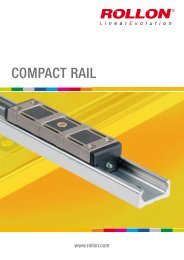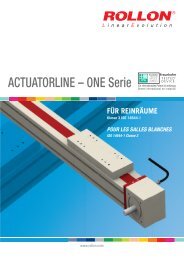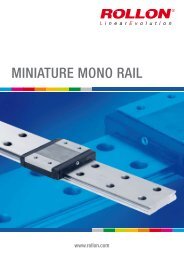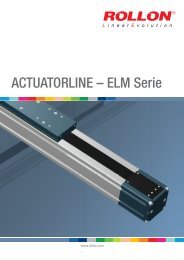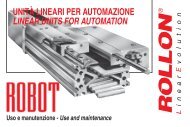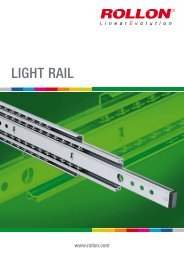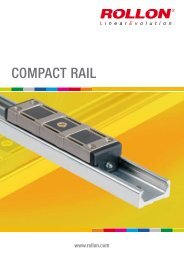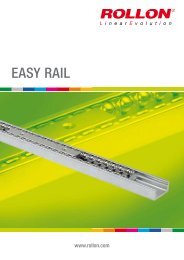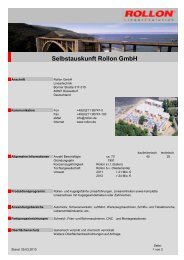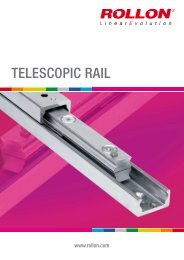MONO RAIL (pdf; EN) - Rollon
MONO RAIL (pdf; EN) - Rollon
MONO RAIL (pdf; EN) - Rollon
Create successful ePaper yourself
Turn your PDF publications into a flip-book with our unique Google optimized e-Paper software.
Content4 AccessoriesSafety equipment and coversMetal cover strip, Flush capClamping elementsManual clamp HKPneumatic clamp MK / MKSAdapter plate5 Technical instructionsPrecisionRadial clearance / preloadAnticorrosive protection, LubricationLubrication nippleFriction / displacement resistanceLoadingService lifeInstallation instructionsInstallation examples161819202122232425262728293035Ordering keyOrdering key with explanations and hole patternPortfolio
Product explanation 1Product explanationMono Rails are profile rails for the highest degree of precisionFig. 1The running grooves are ground in semicircular profile and have a contactangle of 45° in X-arrangement so that the same load capacity is guaranteedin all principle directions. Use of large steel balls enables high loadand moment capacities. All carriages in size 55 are equipped with ballchains.The most important characteristics:■ X-arrangement with 2-point contact of the raceways■ Uniform loading capacity in all main directions■ High ability for self-regulating■ Small differential slip in comparison to 4-point contact■ Very quiet running and low operating noise■ Low maintenance due to advanced lubrication chamber■ Small displacement force in preload compared to 4-point contact■ Mono Rail profile rails meet the market standard and can replacelinear rails of the same design from other manufacturers whilemaintaining the main dimensionsPreferred areas of application:■ Construction and machine technology ( safety doors, feeding )■ Packaging machines■ Special purpose machinery■ Logistics ( e.g., handling units )■ Medical technology ( e.g., X-ray equipment, hospital gurneys )www.rollon.com5
Technical data 2Load capacitiesC 0axC 0radFig. 10M xM zTypeLoad capacities[N]Static moments[Nm]TypeLoad capacities[N]Static moments[Nm]dyn. Cstat. C 0radM xM yM zstat. C 0axdyn. Cstat. C 0radM xM yM zstat. C 0axMRS15MRS15WMRT15W8500 13500 100 68 68MRS30MRS30WMRT30W28500 48000 672 432 432MRT15SW 5200 6800 51 18 18MRT30SW 17500 24000 336 116 116MRS20MRS20WMRT20W14000 24000 240 146 146MRS30LMRS30LWMRT30LW36000 64000 896 754 754MRT20SW 9500 14000 70 49 49MRS20LMRS20LWMRS25MRT25MRS25WMRT25WMRZ25W16500 30000 300 238 23819500 32000 368 228 228MRS35MRS35WMRT35W38500 62000 1054 620 620MRT35SW 25000 36500 621 209 209MRS35LMRS35LWMRT35LW48000 83000 1411 1098 1098MRT25SMRT25SW12500 17500 175 69 69MRS45MRS45WMRT45W65000 105000 2363 1378 1378MRS25LMRS25LWMRT25LWM yTab. 126000 46000 529 455 455MRS45LMRS45LWMRT45LW77000 130000 2925 2109 2109MCS55MCS55WMCT55W123500 190000 4460 3550 3550MCS55LMCS55LWMCT55LW155000 249000 5800 6000 6000Tab. 2www.rollon.com9
4 AccessoriesAccessoriesSafety equipment and coversEnd sealCarriages of Mono Rail profile rails are equipped with end seals forcontamination protection as standard.End sealFig. 17Side sealTo prevent permeation of foreign matter from below, the carriages for thisarea are offered with appropriate seals.No side seals are available for carriages in long or short version(...S / S...W and ...L / L...W ).Side sealFig. 18Double sealTo improve the protection from contamination at higher loads the carriagecan be provided with double end seals.End sealSpacer plateEnd sealFig. 19Metal deflector (non-contacting)Metal cuttings or coarse contamination can damage the end seals of thecarriage. Metal deflector covers protect seal lips against damage.End sealMetal deflectorFig. 2016 www.rollon.com
4 AccessoriesAdapter plateFor HK clampsClamp Size Slider type Adapter plate DHK1501A 15HK2006A 20HK2514AMRS, MRT...W, MRT...SW - 24MRS...W PHK 15-4 28MRT...S, MRT...W, MRT...SW - 28MRS, MRS...L, MRS...W, MRS...LW - 30MRT, MRT...S, MRT...W, MRT...SW, MRT...LW - 33HK2501A25MRS, MRS...L, - 36MRS...W, MRS...LW PHK 25-4 40HK3001A 30HK3501A 35HK4501A 45On requestMRS, MRS...L, MRT...W, MRT...SW, MRT...LW - 42MRS...W, MRS...LW PHK 30-3 45MRS, MRS...L, MRT...W, MRT...SW, MRT...LW - 48MRS...W, MRS...LW PMK 35-7 55MRS, MRS...L, MRT...W, MRT...LW - 60MRS...W, MRS...LW PHK 45-10 70MRT...W, MRT...LW - 68HK5501AFor MK / MKS clamps55MRS, MRS...L - 70MRS...W, MRS...LW PHK 55-10 80Tab. 16Clamp Size Slider type Adapter plate DMK / MKS1501AMK / MKS2001AOn requestMK / MKS2501AMK / MKS3001AMK / MKS3501AMK / MKS4501AOn request152025303545MRS, MRT...W, MRT...SW - 24MRS...W PMK 15-4 28MRT...S, MRT...W, MRT...SW - 28MRS, MRS...L, MRS...W, MRS...LW PMK 20-2 30MRT, MRT...S, MRT...W, MRT...SW, MRT...LW - 33MRS, MRS...L, MRZ - 36MRS...W, MRS...LW PMK 25-4 40MRS, MRS...L, MRT...W, MRT...SW, MRT...LW - 42MRS...W, MRS...LW PMK 30-3 45MRS, MRS...L, MRT...W, MRT...SW, MRT...LW - 48MRS...W, MRS...LW PMK 35-7 55MRS, MRS...L, MRT...W, MRT...LW - 60MRS...W, MRS...LW PMK 45-10 70MRT...W, MRT...LW - 68MK / MKS 55MRS, MRS...L - 705501AMRS...W, MRS...LW PMK 55-10 8022 www.rollon.comTab. 17
Technical instructions 5Technical instructionsPrecisionPrecision means the guide accuracy or the maximal deviation of the carriagebased on the side and support surfaces during the movement alongthe rails.CDCDHHACWDBCDAWBFig. 25HAbb. 1HPrecision class[mm]Height tolerance HSide tolerance WA W BNormal[N]AHighW[H]Precise[P]± 0.1 ± 0.04 0 to -0.04BGuide accuracy of raceway C based onsurface AGuide accuracy of raceway D based onsurface B∆C see graph in fig. 26∆D see graph in fig. 26Tab. 18(*) beim Einsatz mehrerer Läufer / Schienen∆ C (μm) (µm)∆ D (µm)D (μm)Normal Normal ( N) (N)Hoch High ( (H)Präzise Precise ( P (P) )Schienenlänge (mm)Rail length (mm)Fig. 26www.rollon.com23
5 Technical instructionsRadial clearance / preloadRadial clearance describes the value for the radial movement of the carriageat a constant vertical load, while the carriage moves in longitudinaldirection.Fig. 27Preload is defined as an effective load on the rolling element in the interiorof the carriage in order to remove an existing clearance or to increasethe rigidity.The Mono Rail profile rails are available in the four different preloadclasses G1, K0, K1 and K2 ( see tab. 19 ). The preload influences the rigidity,precision and torque resistance and also affects the service life anddisplacement force.The radial clearance for the respective preload classes are listed intable 20.Degree of preload Preload class PreloadWith clearance G1 0No clearance K0 0Small preload K1 0,02 x C*Average preload K2 0,05 x C** C is the dynamic load capacity, see pg. 9, tab. 1fTab. 19SizeRadial clearance of the preload classes[µm]G1K0K1K2Impact free movement,compensationof assemblytolerancesImpact free andeasy movementSmall moments, onerail application, lowvibrationsAverage vibrationsand moments, lightimpacts15 +4 to +14 -4 to +4 -12 to -4 -20 to -1220 +5 to +15 -5 to +5 -14 to -5 -23 to -1425 +6 to +16 -6 to +6 -16 to -6 -26 to -1630 +7 to +17 -7 to +7 -19 to -7 -31 to -1935 +8 to +18 -8 to +8 -22 to -8 -35 to -2245 +10 to +20 -10 to +10 -25 to -10 -40 to -2555 +12 to +22 -12 to +12 -29 to -12 -46 to -29Tab. 2024 www.rollon.com
Technical instructions 5Anticorrosive protectionThere are numerous application-specific surface treatments available forprofile rails of the Mono Rail product family, for example, black coating ( X ),hard chrome plating ( XC ) or nickel plating ( NIC ), also with FDA-approvalfor use in the food industry. For more information please contact ApplicationTechnology.LubricationProfile rails must generally be lubricated before commissioning. They canbe lubricated with oil or grease.The correct lubricant selection has a large influence on the service life andthe function of the profile rail, insufficient lubrication and tribocorrosioncan ultimately lead to total failure.As well as reducing friction and wear, lubricants also serve as sealant,noise damper and corrosion protection for the linear guide. Different lubricantsfor special applications are available upon request.Example: Lubricant with FDA approval for use in the food industry.For more information please contact Application Technology.Important instructions for lubrication■ Mono Rail profile rails must be lubricated for operation.■ The carriage must be moved back and forth during lubrication.■ The lubricant is inserted through a lubrication nipple.■ There should be a thin film of lubricant on the rail surface at all times.■ Please inform us in advance if the guides are to be used in acid or basecontaining environments or in clean rooms.■ Primary lubricated systems have an increased displacement resistance.■ Please contact Application Technology if the oil lubrication is used forvertical use.■ If the stroke is < 2 or > 15 times the carriage length, the lubricationintervals should be shortened.Grease lubricationWe recommend the use of a lithium emulsified lubricant NLGI Class 2 forlubrication.Oil lubricationWe recommend a synthetic oil for operating temperatures between 0 °Cand +70 °C. For application-specific custom lubrication, please contactApplication Technology.Relubrication■ Relubrication of the system must be done before the lubricant used isdirty or shows discolouration.■ Relubrication is performed at operating temperature. The carriagemust be moved back and forth during relubrication.■ If the stroke is < 2 or > 15 times the carriage length, the lubricationintervals should be more often.Lubrication intervalsOperating speed, stroke length and ambient conditions influence theselection of time between lubrication intervals. Establishing a safe lubricationinterval is based exclusively on the experienced practiced valuesdetermined on site. However, a lubrication interval should not be longerthan one year in any case.www.rollon.com25
5 Technical instructionsLoadingThe given static load capacity for each carriage represents the maximumpermissible load value, which if exceeded causes permanent deformationsof the raceways and adverse effects of the running properties.Checking the load must be done as follows:- through determination of the simultaneously occurring forces andmoments for each carriage- by comparison of these values with the corresponding load capacities.The ratio of the actual load to maximum permissible load may be as largeas the reciprocal of the accepted safety factor, S 0, at the most.P 0rad1≤P 0ax1≤M 11≤M 21≤M 31≤C 0radS 0C 0axS 0M xS 0M yS 0M zS 0Fig. 31The above formulas are valid for a single load case.If two or more forces are acting simultaneously, please check the followingformula:P 0radP 0axM 1M 2M+ + + +3≤C 0radC 0axM xM yM z1S 0P 0radC 0radP 0axC 0ax= effective radial load (N)= permissible radial load (N)= effective axial load (N)= permissible axial load (N)M 1, M 2, M 3= external moments ( Nm)M x, M y, M z= maximum permissible momentsin the different loading directions (Nm)Fig. 32Safety factorOperating conditions S 0Normal operation 1 ~ 2Loading with vibration or shock effect 2 ~ 3Loading with strong vibration or impacts ≥ 3Tab. 25The safety factor S 0can lie on the lower given limit if the occurring forcescan be determined with sufficient precision. If shock and vibration arepresent, the higher value should be selected. For dynamic applicationshigher safety is required. Please contact the Application Engineering Department.28 www.rollon.com
Technical instructions 5Service lifeCalculation of service life:The dynamic load capacity C is a conventional variable used for calculatingthe service life. This load corresponds to a nominal service life of 50km. The relationship between calculated service life L km( in km ), dynamicload capacity C ( in N ) and equivalent load P ( in N ) is given in the formulato the right:C fL km= ( · c) 3 · 50 kmPf if c= contact factorf i= application coefficientFig. 33The equivalent load P corresponds in its effects to the sum of the forcesand moments working simultaneously on a slider. If these different loadcomponents are known, P results from the equation to the right:| MP = | P 0ax| + | P 0rad| + ( 1| | M+ 2| | M+ 3|) · CM0radxM yM zFig. 34Contact factor f cThe contact factor f crefers to applications in which several carriages passthe same rail section. If two or more carriages are moved over the samepoint on a rail, the static and dynamic loading values must be multipliedwith the numbers from the table below:Number ofcarriages1 2 3 4 5f c1 0.81 0.72 0.66 0.61Tab. 26Application coefficient f iThe application coefficient f ican be understood as the dynamic safetyfactor. Refer to the table below for the values:Operational conditions Speed f iNeither external impacts nor vibrations Low speed V ≤ 15 m/min. 1 - 1.5Light impacts or vibrations Average speed 15 < V ≤ 60 m/min. 1.5 - 2Average and high external impacts or vibrations High speed V > 60 m/min. 2 - 3.5Tab. 27www.rollon.com29
5 Technical instructionsInstallation instructionsThe given radii and shoulder heights in the table must be observed whenassembling rails and carriages on the stop edges to ensure perfect seatingof carriages or raceways.Ground surfaceSmSmHcHrGround stopsurfaceLvLvSmSmFig. 35SizeMaximum level ofinclineMaximum height ofrail shoulderMaximum height ofrail shoulder whenusing the side sealMaximum height ofslider shoulderRequired boltlengths (rails)Sm[mm]Hr[mm]Hr*[mm]Hc[mm]Lv[mm]154 1.9 5 M4 x 160.820 4.5 2.4 6 M5 x 20256 3.9 7 M6 x 2530 1.28 5.9 8M8 x 3035 8.5 6.6 94512 10.5 11 M12 x 401.655 13 - 12 M14 x 45Tab. 28* For use of various seals, see pg. 16, fig. 17ff30 www.rollon.com
Technical instructions 5Assembly precisionThe maximum permissible deviations of the rail surfaces for assemblyare given in the following drawing ( see fig. 36 ) and the table below( see tab. 29 ):p1p2Fig. 36SizePermissible tolerance for parallelism p1[µm]Permissible tolerance for parallelism p2[µm]K2 K1 K0 G1 K2 K1 K0 G115 - 18-25 3520 18 20 5085 13025 20 22 30 42 70 19530 27 30 40 55 90 110 170 25035 30 35 50 68 120 150 210 29045 35 40 60 85 140 170 250 35055 45 50 70 95 170 210 300 420Tab. 29190The bolt sizes to be used and optimum tightening torques for rail assemblyare listed in the table below ( see tab. 30 ).BoltTightening torque M t[Nm]Steel Cast iron AluminiumM4 4 3 2M5 9 6 4M6 14 9 7M8 30 20 15M12 118 78 59M14 157 105 78Tab. 30www.rollon.com31
5 Technical instructionsComposite railsGuide rails longer than the one part maximum length ( see Ordering key,tab. 31), are put together from two or more rails.When putting guide rails together, be sure that the register marks shownin fig. 37 are positioning correctly.These are fabricated axisymmetric for parallel application of compositeguide rails, unless otherwise specified.Two railsComp. LJointA ASeveral railsJointJoint marksComp. LJointA1 A1Joint marksJointJointA2 A2Joint marksB1 B1 B2 B2Joint marksJoint marksFig. 3732 www.rollon.com
Technical instructions 5Assembly processAdjacent constructionSet screw (slider)Set screw (rail)Sub-constructionFig. 38Fixing guide rails:( 1) Whet the assembly surface with a whetstone and also remove burrs,unevenness and dirt ( see fig. 39 ).Note: All linear guides are preserved with anticorrosion oil at the factory.This protection must be removed before installation.In doing so, please ensure that the surfaces are coated with low-viscosityoil for the purpose of further protection against corrosion.Fig. 39( 2 ) Carefully lay the guide rail on the assembly surface ( see fig. 40 ) andslightly tighten the fixing screws so that the guide rail lightly touches theassembly surface( align the guide rail along the shoulder edge of the assembly surface, seefig. 41 ).Note: The fixing screws of the linear guide must be clean. Check if thefixing holes are located in the correct place when you insert the bolts. Aforced tightening of a fixing screw in an offset hole can negatively affectaccuracy.Fig. 40www.rollon.comFig. 4133
5 Technical instructions( 3 ) Tighten the thrust bolts on the guide rail until there is close contact onthe side stop surface ( see fig. 42 ).Fig. 42( 4 ) Tighten the fixing screws with a torque wrench to the prescribed torque( see pg. 31, tab. 30 ).Note: For a high degree of accuracy, the fixing screws of the guide railmust be tightened in sequence outward from the centre ( see fig. 43 ).( 5 ) Assemble the other rails in the same manner to complete the installationof the guide rails.1432Fig. 43Table assembly:( 6 ) Set the table carefully on the carriage and tighten the fixing screwsonly lightly.( 7 ) Press the carriage on the main guide side with the thrust bolts againstthe shoulder edge of the table and position the table.( 8 ) Tighten the fixing screws on the main side and the lateral side completelytight to finish the installation. Note:To attach the table uniformly, tighten the fixing screws diagonally ( seefig. 44 ). This method saves time when straightening the guide rail andmakes the manufacture of positioning pins unnecessary, which considerablyreduces assembly time. Fig. 4434 www.rollon.com
Technical instructions 5Installation examplesThe following drawings illustrate some assembly examples for rail/carriagecombinations corresponding to the structure of various machine frames:Example 1:Assembly of carriage and rail on shoulder edgesExample 2:Securing carriage and rail using set screwsExample 3:Securing carriage and rail using set pressure platesExample 4:Securing carriage and rail using taper gibsExample 5:Securing carriage and rail using boltsFig. 45www.rollon.com35
Ordering keyOrdering keyRail / slider systemMRS30W H K1 A HC 1 05960 F T HCTypeSurface coating for railoptional see pg. 25,Anticorrosive protectionJoint processed rails optionalsee pg. 32, Composite railsRails bolted from below, optional see pg. 15Total rail lengthNumber of carriagesSurface coating for carriage optional see pg. 25, Anticorrosive protectionSeal variants see pgs. 16fPreload class see pg. 24, tab. 19fPrecision class see pg. 23, tab. 18Ordering example: MRS30W-H-K1-A-HC-1-05960F-T-HCRail composition: 1x3100+1x2860 (only for joint processed rails)Hole pattern: 20-38x80-40//40-35x80-20 (please always indicate the hole pattern separately)Notes on ordering: The rail lengths are always indicated as 5 digits with 0 prefixesRailMRR 20 6860 N F T HCSurface coating for rail optionalsee pg. 25, Anticorrosive protectionRail typeSizeJoint processed rails optional see pg. 32, Composite railsRails bolted from below, optional see pg. 15Precision class see pg. 23, tab. 18Total rail lengthOrdering example: MRR20-06850-NF-T-HCRail composition: 1x2920+1x3940 (only for joint processed rails)Hole pattern: 10-48x60-30//30-65x60-10 (please always specify the hole pattern separately)Notes on ordering: The rail lengths are always indicated as 5 digits with 0 prefixes
Ordering keyCarriageMRS35 N K0 A HCTypeSurface coating for carriage optionalSeal variants see pgs. 16fPreload class see pg. 24, tab. 19fPrecision class see pg. 23, tab. 18see pg. 25, Anticorrosive protectionOrdering example: MRS35-N-K0-A-HCHole patternRailL 2+ – 0,5 mmP L +3 – 0,5 mmL 0Fig. 46SizeHole pitch P[mm]L 2min, L 3min[mm]L 2max*, L 3max*[mm]L 0max[mm]152060 740002520303580 8.5 396045 105 11.5 22.5 393055 120 13 30 3900Tab. 31* Only applies when using max. rail lengths
PortfolioPortfolioCOMPACT <strong>RAIL</strong>Rugged roller sliders with innovativeself adjustmentMINIATURE <strong>MONO</strong> <strong>RAIL</strong>Miniature format profile guidewayswith unique ball designCURVILINECurvilinear rails for constantand variable radiiTELESCOPIC <strong>RAIL</strong>Smooth-running telescopic linearbearing drawer slides withlow deflection under heavy loadsEASY <strong>RAIL</strong>Compact, versatile linear bearingsX-<strong>RAIL</strong>Roller embossed stainless steel profilesfor the use in rough environmentsUNILINESteel-reinforced, belt-driven linear actuatorswith hardened steel linear bearingsand precision radial ball bearing rollersLIGHT <strong>RAIL</strong>Full and partial extension, lightweightdrawer slides
Fold out ordering keyFold out ordering keyTo make this product catalog as simple as possible for you to use, we haveincluded the following easy-to-read chart.Your advantages:■ Description and ordering designations easy to read at one glance■ Simplified selection of the correct product■ Links to detailed descriptions in the catalog
ROLLON S.r.l.Via Trieste 26I-20871 Vimercate (MB)Tel.: (+39) 039 62 59 1Fax: (+39) 039 62 59 205E-Mail: infocom@rollon.itItalywww.rollon.itGermanyROLLON GmbHBonner Strasse 317-319D-40589 DüsseldorfTel.: (+49) 211 95 747 0Fax: (+49) 211 95 747 100E-Mail: info@rollon.dewww.rollon.deNetherlandsROLLON B.V.Ringbaan Zuid 86905 DB ZevenaarTel.: (+31) 316 581 999Fax: (+31) 316 341 236E-Mail: info@rollon.nlwww.rollon.nlFranceROLLON S.A.R.L.Les Jardins d‘Eole, 2 allée des SéquoiasF-69760 LimonestTel.: (+33) (0)4 74 71 93 30Fax: (+33) (0)4 74 71 95 31E-Mail: infocom@rollon.frwww.rollon.frUSAROLLON Corporation101 Bilby Road. Suite BHackettstown, NJ 07840Tel.: (+1) 973 300 5492Fax: (+1) 908 852 2714E-Mail: info@rolloncorp.comwww.rolloncorp.comAll addresses of our global sales partners can alsobe found in the internet at www.rollon.comChanges and errors excepted. The text and images may be used only with our permission.RL_MR_<strong>EN</strong>_07/13



